story and photos by Kayte Deioma
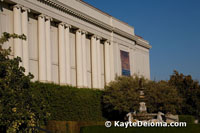 At the edge of the affluent community of San Marino, bordering on Pasadena sits the grand estate of Henry E. Huntington, a railroad and utilities magnate who bought the property in 1903 and used it as a base for developing the San Gabriel Valley. Huntington and his second wife, Arabella, filled the mansion they built on the grounds in 1911 with a world-class collection of British and French art.
At the edge of the affluent community of San Marino, bordering on Pasadena sits the grand estate of Henry E. Huntington, a railroad and utilities magnate who bought the property in 1903 and used it as a base for developing the San Gabriel Valley. Huntington and his second wife, Arabella, filled the mansion they built on the grounds in 1911 with a world-class collection of British and French art.
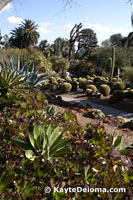 There wasn’t enough room in the house to bring Huntington’s extensive book collection from New York, so he built a separate library building to house the thousands of first editions, historic documents and volumes on the American West. It took multiple railroad cars to bring the collected works to California when the building was finished in 1921. Meanwhile, out on the ranch, a landscape gardener by the name of William Hertrich was busy turning farmland into a showcase of diverse botanical specimens from the local deserts and around the world. Following Huntington’s instructions, the non-profit trust that he formed opened the Huntington Library, Art Collections and Botanical Gardens to the public in 1928, a year after his death.
There wasn’t enough room in the house to bring Huntington’s extensive book collection from New York, so he built a separate library building to house the thousands of first editions, historic documents and volumes on the American West. It took multiple railroad cars to bring the collected works to California when the building was finished in 1921. Meanwhile, out on the ranch, a landscape gardener by the name of William Hertrich was busy turning farmland into a showcase of diverse botanical specimens from the local deserts and around the world. Following Huntington’s instructions, the non-profit trust that he formed opened the Huntington Library, Art Collections and Botanical Gardens to the public in 1928, a year after his death.
Many who visit the Huntington spend all of their time in the Gardens, which is easy to do on a lovely Southern California day. However, if you’re visiting during the winter rains or want to escape the summer heat, there is plenty to do indoors to keep the whole family occupied.
The Huntington Library
The Huntington Library is not your ordinary lending library. The collection contains over 5 million books, manuscripts, photographs and other works related to American and British history, literature and art. Most of these are hidden away in the Munger Research Center, available only to visiting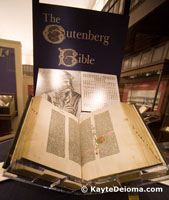 scholars and researchers by special arrangement. For the rest of us, the Library Galleries display some of the most famous pieces along with rotating exhibits.
scholars and researchers by special arrangement. For the rest of us, the Library Galleries display some of the most famous pieces along with rotating exhibits.
One of the best known volumes on display is an original illuminated Gutenberg Bible from around 1455. This is one of the earliest works printed with movable type. Johann Gutenberg is thought to have printed about 180 copies of the Latin bible in his workshop in Mainz, Germany, 45 on vellum and 135 on paper. The Huntington has one of only 12 surviving copies printed on vellum. Only one of the two volume set is on display.
Another highlight of the exhibit is the 15th century Ellsmere manuscript of Chaucer’s The Canterbury Tales, which Huntington purchased from the 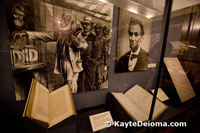 4th Earl of Ellsmere. A double-elephant folio edition of Audubon’s Bird’s of America and early editions of Shakespeare’s works are other rare finds. In the 19th Century British and American Literature section, there are personal letters from Charlotte Bronte, Henry David Thoreau, Walt Whitman and Harriet Beecher Stowe. American history documents include papers related to Abraham Lincoln and the 13th Amendment to the Constitution. The History of the American West is laid out in personal letters, articles, books and photos.
4th Earl of Ellsmere. A double-elephant folio edition of Audubon’s Bird’s of America and early editions of Shakespeare’s works are other rare finds. In the 19th Century British and American Literature section, there are personal letters from Charlotte Bronte, Henry David Thoreau, Walt Whitman and Harriet Beecher Stowe. American history documents include papers related to Abraham Lincoln and the 13th Amendment to the Constitution. The History of the American West is laid out in personal letters, articles, books and photos.
The Art Collections
In the West Wing of the Library, one of the most renowned pieces in the Huntington’s collection, Rogier van der Weyden’s 15th century Madonna and Child, is displayed among Renaissance paintings and French decorative arts and furnishings.
The Huntington Gallery is historically housed in the Huntington’s 1911 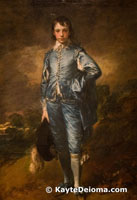 Georgian mansion. However, the mansion is undergoing renovations until summer of 2008, so the French and British art normally on view in the rooms of the main house are temporarily on display in the Erburu Gallery. This includes an impressive group of elegant full-length Grand Manner portraits by Gainsborough, Romney, Reynolds and Lawrence. Two favorites, Gainsborough’s Blue Boy and Lawrence’s Pinkie, which traditionally hung side by side in the mansion, occupy different rooms in the Erburu Galley.
Georgian mansion. However, the mansion is undergoing renovations until summer of 2008, so the French and British art normally on view in the rooms of the main house are temporarily on display in the Erburu Gallery. This includes an impressive group of elegant full-length Grand Manner portraits by Gainsborough, Romney, Reynolds and Lawrence. Two favorites, Gainsborough’s Blue Boy and Lawrence’s Pinkie, which traditionally hung side by side in the mansion, occupy different rooms in the Erburu Galley.
The Lois and Robert F. Erburu Gallery is a wing that was added to the Virginia Steel Scott Gallery in 2005, so you don’t have to go outside to continue to the Scott Gallery. Here you will find paintings by American artists such as Mary Cassatt, John Singer Sargent, and Edward Hopper and sculptures by Frederick Remington.
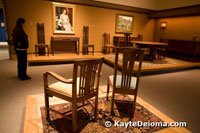 There are several rooms in the Scott Gallery dedicated to the Arts and Crafts Movement in architecture and furnishings. Highlights include three Frank Lloyd Wright chairs and a room devoted to the furniture, textiles and other designs of William Morris and his followers. The largest gallery showcases the work of local architects Henry and Charles Greene who built the Gamble House and many other notable Pasadena properties. There are two fully furnished dining areas with tables, chairs, sideboards, cupboards and leaded glass lamps.
There are several rooms in the Scott Gallery dedicated to the Arts and Crafts Movement in architecture and furnishings. Highlights include three Frank Lloyd Wright chairs and a room devoted to the furniture, textiles and other designs of William Morris and his followers. The largest gallery showcases the work of local architects Henry and Charles Greene who built the Gamble House and many other notable Pasadena properties. There are two fully furnished dining areas with tables, chairs, sideboards, cupboards and leaded glass lamps.
The Boone Gallery, located in the remodeled multi-car garage, hosts temporary exhibits.
The Botanical Gardens
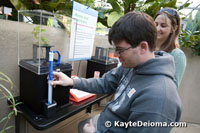 You can don your rain gear and explore the 120 acres divided into 12 themed gardens or you can escape into the Rose Hills Foundation Conservatory for Botanical Science which opened in 2005. Designed to appeal to middle school students, the glass-enclosed science lab allows kids and adults to zoom in on plants and bugs with magnifying video cameras that show the image on large LCD screens. You can test the sugar content of different plant nectars, see how helicopter and parachute seeds are carried by the wind, discover up close why burrs get caught in your
You can don your rain gear and explore the 120 acres divided into 12 themed gardens or you can escape into the Rose Hills Foundation Conservatory for Botanical Science which opened in 2005. Designed to appeal to middle school students, the glass-enclosed science lab allows kids and adults to zoom in on plants and bugs with magnifying video cameras that show the image on large LCD screens. You can test the sugar content of different plant nectars, see how helicopter and parachute seeds are carried by the wind, discover up close why burrs get caught in your 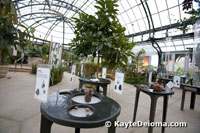 socks, measure the nutrient levels in plant water and generally touch and smell different kinds of plants. If you’ve been through the Art Galleries, you can look for the plants that were in some of the paintings. The popular carnivorous bug-eating plant lab occupies one whole end of the Conservatory. Behind the glass-domed building is the Teaching Greenhouse with more hands-on discovery activities for kids and families.
socks, measure the nutrient levels in plant water and generally touch and smell different kinds of plants. If you’ve been through the Art Galleries, you can look for the plants that were in some of the paintings. The popular carnivorous bug-eating plant lab occupies one whole end of the Conservatory. Behind the glass-domed building is the Teaching Greenhouse with more hands-on discovery activities for kids and families.
The Rose Garden Tea Room and Café
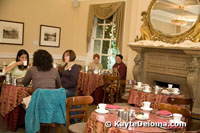 English Tea is served Tuesday through Sunday in the Rose Garden Tea Room. Your English tea consists of a pot of tea, a basket of mini scones and a buffet of bite-size tea sandwiches and mini pastries. The Rose Garden Café on the back of the Tea Room serves deli sandwiches, grill items, snacks and beverages. During the summer you need an advance reservation for the Tea Room, but on a weekday in winter, you can probably walk in or get a reservation on site. No reservations are needed at the Café.
English Tea is served Tuesday through Sunday in the Rose Garden Tea Room. Your English tea consists of a pot of tea, a basket of mini scones and a buffet of bite-size tea sandwiches and mini pastries. The Rose Garden Café on the back of the Tea Room serves deli sandwiches, grill items, snacks and beverages. During the summer you need an advance reservation for the Tea Room, but on a weekday in winter, you can probably walk in or get a reservation on site. No reservations are needed at the Café.
Gift Shop
The Huntington has a first class gift shop and book store where you could probably spend another hour browsing through the books on art and history related to the Huntington collections and other typical museum gift shop items. The store stays open an additional half hour after the Library, Galleries and Gardens close, so you have a chance to stop on your way out.
The Huntington Library, Art Collections and Botanical Gardens
1151 Oxford Road (main entrance at Orlando Road at Allen Avenue)
San Marino, CA 91108
Phone: (626) 405-2100
www.huntington.org

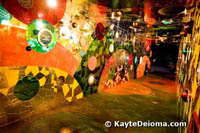 But the signs are easy to spot and they led me into the vast Parking Lot 1, then past the camouflage of uniform-clad soccer teams and bushy trees and up to a big white house with a little round sign near the ground next to the entrance. The contrast between the businesslike exterior and the fantasy that begins as you enter the Kidspace Museum is startling.
But the signs are easy to spot and they led me into the vast Parking Lot 1, then past the camouflage of uniform-clad soccer teams and bushy trees and up to a big white house with a little round sign near the ground next to the entrance. The contrast between the businesslike exterior and the fantasy that begins as you enter the Kidspace Museum is startling.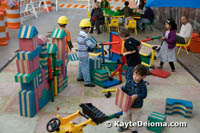 building to the ticket booth that juts into the inner courtyard. Beyond the ticket booth, are two distinct worlds. Mothers at courtyard tables sip their mochas from the Nestle Café by Wolfgang Puck. Just feet away, kids in hard hats work together to create structures of giant blocks or PVC pipe and plastic squares as others drive pint size construction vehicles in the Blasting Zone. Steam shoots up from the pavement, reminiscent of the streets of New York, not Pasadena.
building to the ticket booth that juts into the inner courtyard. Beyond the ticket booth, are two distinct worlds. Mothers at courtyard tables sip their mochas from the Nestle Café by Wolfgang Puck. Just feet away, kids in hard hats work together to create structures of giant blocks or PVC pipe and plastic squares as others drive pint size construction vehicles in the Blasting Zone. Steam shoots up from the pavement, reminiscent of the streets of New York, not Pasadena.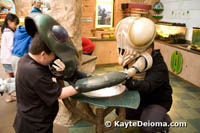 Kids can interact and get a bug’s eye view with people-sized bugs and become servers or customers inBugsy’s Diner or get up close and personal with a real bee hive. They can go on an archaeological dig and discover fossils and dinosaur bones, create an earthquake by moving tectonic plates, drive a jeep or climb up and up and up on all kinds of climbing towers. Supervised art and activity stations let them get as messy and creative as they want.
Kids can interact and get a bug’s eye view with people-sized bugs and become servers or customers inBugsy’s Diner or get up close and personal with a real bee hive. They can go on an archaeological dig and discover fossils and dinosaur bones, create an earthquake by moving tectonic plates, drive a jeep or climb up and up and up on all kinds of climbing towers. Supervised art and activity stations let them get as messy and creative as they want.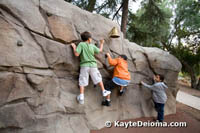 Through the glass doors the Nature Exchange provides hands on opportunities to learn about rocks and fossils. Kids can bring their favorite stones and trade them for different ones.
Through the glass doors the Nature Exchange provides hands on opportunities to learn about rocks and fossils. Kids can bring their favorite stones and trade them for different ones.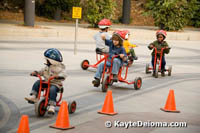 This area really sets Kidspace apart from most other children’s museums. Immediately behind the Digging Deeper building, is the paved Wisteria Courtyard. On one side is Kirby’s Kid’s Korner, where kids can play on a small playground. Most of the rest of the pavement is covered by the Trike Tracks where kids can race around on solo or tandem trikes. In the Stone Hollow Amphitheater on the hillside above the courtyard, staff present educational and interactive shows with costumed characters if the weather is good. The hillside is landscaped as a miniature version of Pasadena’s Arroyo Seco, with a trickle of a stream running down the rocky hill. TheSpider Web Climber, Bat Cave, and the Strata Cliff Climb rock climbing wall are popular highlights of the outdoor exhibit.
This area really sets Kidspace apart from most other children’s museums. Immediately behind the Digging Deeper building, is the paved Wisteria Courtyard. On one side is Kirby’s Kid’s Korner, where kids can play on a small playground. Most of the rest of the pavement is covered by the Trike Tracks where kids can race around on solo or tandem trikes. In the Stone Hollow Amphitheater on the hillside above the courtyard, staff present educational and interactive shows with costumed characters if the weather is good. The hillside is landscaped as a miniature version of Pasadena’s Arroyo Seco, with a trickle of a stream running down the rocky hill. TheSpider Web Climber, Bat Cave, and the Strata Cliff Climb rock climbing wall are popular highlights of the outdoor exhibit.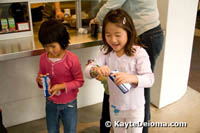 From the central courtyard to the back of the outdoor exhibit, most activities are designed for kids five and up. The Early Childhood Development Center has activities and toys for children four and under in the front building next to the Busy Bee Learning Store. Immediately to the right when you come through the kaleidoscope tunnel is the Nestle Café by Wolfgang Puck. Considering that it is in a museum, the food is reasonably priced, and since it bears the Wolfgang Puck brand, it’s also quite good.
From the central courtyard to the back of the outdoor exhibit, most activities are designed for kids five and up. The Early Childhood Development Center has activities and toys for children four and under in the front building next to the Busy Bee Learning Store. Immediately to the right when you come through the kaleidoscope tunnel is the Nestle Café by Wolfgang Puck. Considering that it is in a museum, the food is reasonably priced, and since it bears the Wolfgang Puck brand, it’s also quite good.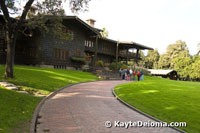 You can’t decide at the spur of the moment that you’d like to tour JPL, but you can look at those rain-bearing clouds and opt for an hour inside the cozy confines of the Gamble House. You don’t really visit the Gamble House to learn about the history of the Gamble family, of the Cincinnati-based Procter & Gamble Company, who summered here. The Gamble House is a masterwork of architects Henry and Charles Greene, who also built many other Arts and Crafts Movement houses in the area.
You can’t decide at the spur of the moment that you’d like to tour JPL, but you can look at those rain-bearing clouds and opt for an hour inside the cozy confines of the Gamble House. You don’t really visit the Gamble House to learn about the history of the Gamble family, of the Cincinnati-based Procter & Gamble Company, who summered here. The Gamble House is a masterwork of architects Henry and Charles Greene, who also built many other Arts and Crafts Movement houses in the area.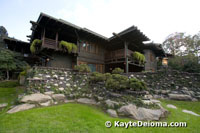 Commissioned in 1907 by David B. and Mary Gamble, the Gamble house incorporates Swiss and Japanese aesthetics and an Arts and Crafts philosophy into a quintessentially California structure. Long eaves shelter the house from the sun. Sleeping porches take advantage of cool evening breezes. Natural redwood shakes covering the exterior were designed to blend with the rustic Arroyo setting that surrounded the house before the area was developed.
Commissioned in 1907 by David B. and Mary Gamble, the Gamble house incorporates Swiss and Japanese aesthetics and an Arts and Crafts philosophy into a quintessentially California structure. Long eaves shelter the house from the sun. Sleeping porches take advantage of cool evening breezes. Natural redwood shakes covering the exterior were designed to blend with the rustic Arroyo setting that surrounded the house before the area was developed.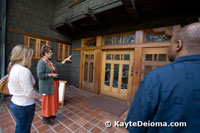 Hour-long docent-led tours begin on the side terrace and take you through the three-panel front door. The panels are adorned with leaded stained glass patterned with oak tree trunks and ginkgo leaves designed by Charles Greene, the more artistic brother. Charles also designed most of the furnishings in the house.
Hour-long docent-led tours begin on the side terrace and take you through the three-panel front door. The panels are adorned with leaded stained glass patterned with oak tree trunks and ginkgo leaves designed by Charles Greene, the more artistic brother. Charles also designed most of the furnishings in the house.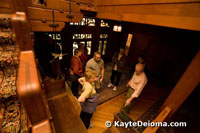 The first thing you notice inside the house is how dark it is. Although the house was built with electricity, the bulbs are very dim and the walls throughout are of dark wood. Our guide uses a flashlight to point out the smooth joinery and the rounded corners and edges on all the Burma teak features and furnishings in the entry hall.
The first thing you notice inside the house is how dark it is. Although the house was built with electricity, the bulbs are very dim and the walls throughout are of dark wood. Our guide uses a flashlight to point out the smooth joinery and the rounded corners and edges on all the Burma teak features and furnishings in the entry hall.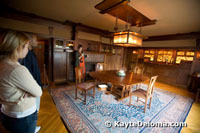 in the neighboring butler’s pantry and servants’ dining porch show just as much attention to detail as in the parts of the house inhabited by the family.
in the neighboring butler’s pantry and servants’ dining porch show just as much attention to detail as in the parts of the house inhabited by the family.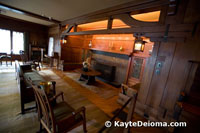 There are two single beds in the master bedroom and one double bed in the boys’ room. The boys are reported to have slept out on the sleeping porch, since they only visited the house on summer breaks from boarding school.
There are two single beds in the master bedroom and one double bed in the boys’ room. The boys are reported to have slept out on the sleeping porch, since they only visited the house on summer breaks from boarding school.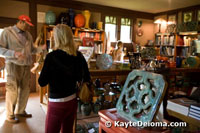 The tour exits downstairs through Mr. Gambles den and back out to the terrace, from where you can explore the small garden or make your way to the Bookstore in the former garage. A walking tour map of other Greene and Greene houses in the neighborhood is available for purchase in the Bookstore.
The tour exits downstairs through Mr. Gambles den and back out to the terrace, from where you can explore the small garden or make your way to the Bookstore in the former garage. A walking tour map of other Greene and Greene houses in the neighborhood is available for purchase in the Bookstore.